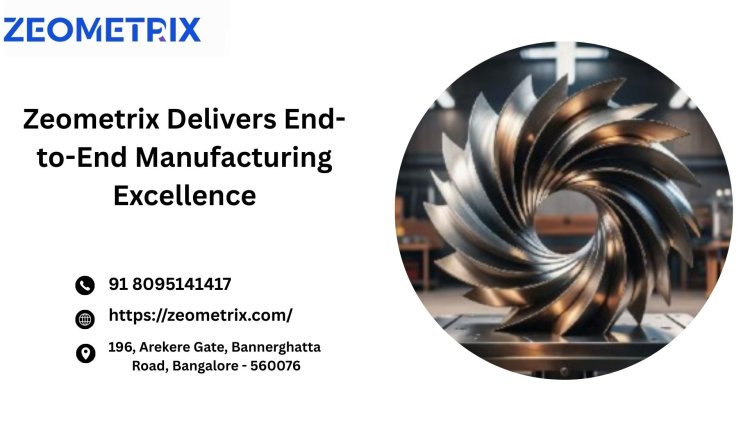Sheet Metal Fabrication Manufacturers: Innovating Precision and Efficiency
Sheet metal fabrication is a cornerstone of modern manufacturing, providing essential components across industries such as automotive, aerospace, electronics, and construction.
Share this Post to earn Money ( Upto ₹100 per 1000 Views )

Sheet metal fabrication is a cornerstone of modern manufacturing, providing essential components across industries such as automotive, aerospace, electronics, and construction. At the heart of this process are sheet metal fabrication manufacturers—specialized entities that transform raw metal sheets into precise, functional parts. This comprehensive guide delves into the world of sheet metal fabrication, exploring the processes, technologies, and considerations that define this vital industry.
Understanding Sheet Metal Fabrication
Sheet metal fabrication involves the creation of metal structures by cutting, bending, and assembling processes. Manufacturers utilize various techniques to transform flat metal sheets into complex shapes and structures. The primary materials used include stainless steel, aluminum, copper, and various alloys, chosen for their strength, durability, and suitability for specific applications.
Core Processes in Sheet Metal Manufacturing
-
Cutting Techniques
-
Laser Cutting: Utilizes a focused laser beam to cut intricate patterns with high precision, ideal for complex designs.
-
Plasma Cutting: Employs ionized gas to cut through thicker materials quickly, suitable for heavy-duty applications.
-
Water Jet Cutting: Uses high-pressure water mixed with abrasives to cut materials without heat distortion, preserving material integrity.
-
CNC Punching: Involves a computer-controlled punch press to create holes and shapes, ensuring consistency in high-volume production.
-
Forming and Bending
-
Press Brake Bending: Applies force to bend metal sheets into desired angles and shapes, essential for creating structural components.
-
Roll Forming: Processes continuous strips of metal through a series of rollers to produce uniform cross-sectional profiles, ideal for long parts.
-
Deep Drawing: Involves drawing a sheet metal blank into a die to form deep, hollow parts, commonly used in automotive and appliance manufacturing.
-
Joining Methods
-
Welding: Techniques like MIG, TIG, and spot welding are employed to fuse metal parts together, ensuring strong and durable joints.
-
Clinching: A mechanical joining process that interlocks two metal sheets without the need for additional fasteners, offering a clean and efficient solution.
-
Riveting and Bolting: Traditional methods used to assemble components, especially in applications requiring disassembly.
-
Finishing Processes
-
Powder Coating: Applies a dry powder that is cured under heat to form a hard finish, providing durability and corrosion resistance.
-
Anodizing: Electrochemically processes aluminum to increase thickness of its natural oxide layer, enhancing corrosion resistance and surface hardness.
-
Bead Blasting and Tumbling: Surface finishing techniques that clean and smooth metal parts, improving aesthetics and preparing surfaces for further treatment.
Technologies Shaping Modern Sheet Metal Fabrication
Advancements in technology have significantly enhanced the capabilities of sheet metal fabrication manufacturers:
-
CNC (Computer Numerical Control) Systems: Allow for precise control of machinery, enabling complex designs and reducing human error.
-
3D CAD (Computer-Aided Design) Software: Facilitates detailed design and simulation, ensuring accuracy before physical production.
-
Automation and Robotics: Streamline repetitive tasks, increase production speed, and improve safety in manufacturing environments.
-
IoT (Internet of Things) Integration: Enables real-time monitoring and predictive maintenance, reducing downtime and enhancing efficiency.
Selecting the Right Sheet Metal Fabrication Manufacturer
When choosing a sheet metal manufacturing , consider the following factors:
-
Experience and Expertise: Look for manufacturers with a proven track record in your industry.
-
Quality Assurance: Ensure they adhere to international standards and certifications.
-
Capabilities and Equipment: Assess their range of services and technological capabilities.
-
Customer Support and Communication: Effective communication is crucial for successful project execution.
-
Cost and Lead Time: Balance affordability with timely delivery to meet project deadlines.
Applications of Sheet Metal Fabrication
Sheet metal fabrication is integral to various sectors:
-
Automotive Industry: Production of body panels, chassis components, and structural parts.
-
Aerospace Sector: Manufacture of aircraft skins, frames, and engine components.
-
Electronics: Enclosures for devices, heat sinks, and structural supports.
-
Construction: HVAC systems, roofing, and structural elements.
-
Medical Devices: Surgical instruments and diagnostic equipment housings.
Future Trends in Sheet Metal Fabrication
The sheet metal fabrication industry is evolving with emerging trends:
-
Sustainability: Increased focus on recycling materials and reducing energy consumption.
-
Smart Manufacturing: Integration of AI and machine learning for process optimization.
-
Customization: Growing demand for bespoke components tailored to specific requirements.
-
Advanced Materials: Development of lightweight and high-strength alloys for specialized applications.
Conclusion
Sheet metal fabrication manufacturers play a pivotal role in transforming raw materials into precise components that drive innovation across industries. By understanding the processes, technologies, and considerations involved, businesses can make informed decisions when selecting partners for their manufacturing needs. As the industry continues to advance, embracing new technologies and practices will be essential for staying competitive and meeting the evolving demands of the market.















